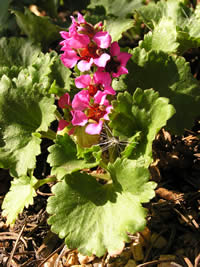Rocky Mountain Region Viewing Area
LOCATION and PHOTOS
 Arctic yellow violet (Viola biflora) is found in moist soil along streams in deep shade. Photo by Steven Olson.
Arctic yellow violet (Viola biflora) is found in moist soil along streams in deep shade. Photo by Steven Olson.
 Dwarf clover (Trifolium nanum) is a tiny legume with just a few flowers on each head. Photo by Steven Olson.
Dwarf clover (Trifolium nanum) is a tiny legume with just a few flowers on each head. Photo by Steven Olson.
 James' telesonix (Telesonix jamesii) can be on shaded or on sunlit granite outcrops. Photo by Steven Olson.
James' telesonix (Telesonix jamesii) can be on shaded or on sunlit granite outcrops. Photo by Steven Olson.
Pikes Peak
By Steve Olson
Forest: Pike National Forest
District: Pikes Peak Ranger District
Description: Perhaps the best-known mountain in the United States, Pikes Peak rises to 14,110 feet along the Front Range of the Colorado Rockies. This dominant feature of the landscape has a wide variety of habitats including ponderosa pine (Pinus ponderosa) woodlands, Engelmann spruce (Picea engelmannii)-subalpine fir (Abies lasiocarpa) forests, bristlecone pine (Pinus aristata) woodlands, and of course extensive areas of alpine tundra. There are also significant areas with quaking aspen (Populus tremuloides), lodgepole pine (Pinus contorta), and subalpine grasslands. The various aspects (north, south, east, and west) and elevations (7,000 to 14,000 feet) account for much of the variety of vegetation on the Peak. Not surprisingly, the entire mountain is composed of rocks of the Pikes Peak batholith, which are about a billion years old. This granite weathers into a coarse, sandy soil, leading to very dry growing conditions over most of the area.
Wildflower Viewing: The flora of Pikes Peak changes with gain in elevation. Columbian monkshood (Aconitum columbianum), orange agoseris (Agoseris aurantiaca), wholeleaf Indian paintbrush (Castilleja integra), and mountain bluebells (Mertensia ciliata) are most frequent in lower elevation sites. In the deep shade of spruce-fir forests, arctic yellow violet (Viola biflora) is occasionally seen. Moist aspen stands may have western yarrow (Achillea millefolium ssp. occidentalis), darkthroat shootingstar (Dodecatheon pulchellum), and elephanthead lousewort (Pedicularis groenlandica), the latter two especially near flowing water. Ross’ avens (Geum rossii), threeflower avens (Geum triflorum), and Whipple’s penstemon (Penstemon whippleanus) occur in many open situations. The alpine flora is diverse but small. Among common species above 12,000 feet are alpine springbeauty (Claytonia megarhiza), arctic-alpine forget-me-not (Eritrichium nanum), Rocky Mountain snowlover (Chionophila jamesii), alpine bluebells (Mertensia alpina), alpine mountainsorrel (Oxyria digyna), moss campion (Silene acaulis), and dwarf clover (Trifolium nanum). There are a few local specialties of Pikes Peak. Rocky Mountain blue columbine (Aquilegia saximontana) is found in the shelter of large rocks and cliffs only in Colorado. James’ telesonix (Telesonix jamesii) has been found only in association with outcrops of the Pikes Peak granite formations. Pikes Peak alpineparsley (Oreoxis humilis) is found only in the tundra and krumholtz communities on Pikes Peak.
Safety First: Weather conditions can change rapidly during summer afternoons. Lightning often starts in the early afternoon, and sometimes in the late morning. Sunscreen is recommended at high elevations because of the intense sunlight. Steep slopes are common throughout the area and the gravelly soil of the trails can be treacherous.
Directions: There are several ways to access Pikes Peak. The Pikes Peak Highway (toll road) is a 19-mile scenic drive to the summit off of US-24 (Cascade) about 9 miles west of Colorado Springs. The Pikes Peak Cog Railway leaves from Manitou Springs and travels to the summit (http://www.cograilway.com/). For hikers, the Barr Trail (#620) also starts in Manitou Springs and ends 13 miles later at the summit, passing through montane, subalpine, and alpine communities. The Crags Trail (#664) climbs the western slope of the Peak. About four miles south of Divide on CO-67, take NFS Road-383 to the left about three miles to the trailhead.
Ownership and Management: U.S. Forest Service, Pike National Forest, Pikes Peak Ranger District: (719) 636-1602.
Nearest Towns: Colorado Springs, Manitou Springs, and Woodland Park, Colorado.

